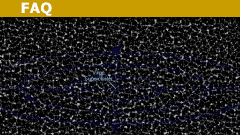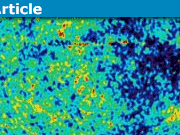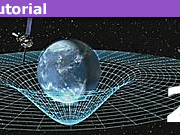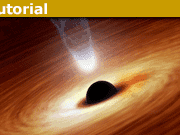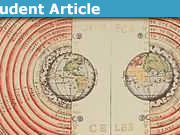Radius of the Observable Universe in Light-years Is Greater than Its Age
The radius of the observable universe is about 46 billion light-years, which is considerably greater than its age of about 14 billion years. The radius of the observable universe is defined by the greatest distance from which light would have had time to reach us since the Big Bang, so you might think that it would lie at a distance of only 14 billion light-years, since x=ct for motion at a constant velocity c. However, a relation like x=ct is only valid in special relativity. When we write down such a relation, we imagine a Cartesian coordinate system (t,x,y,z), which in Newtonian mechanics would be associated with a particular observer’s frame of reference. In general relativity, the counterpart of this would be a Minkowski coordinate frame, but such frames only exist locally. It is not possible to make a single frame of reference that encompasses both our galaxy and a cosmologically distant galaxy. General relativity is able to describe cosmology using cosmological models, and this description is successful in matching up with observations to a high level of precision. In particular, no objects are observed whose apparent ages are inconsistent with their distances from us.
None of this has anything to do with inflation. Inflation makes certain testable predictions about cosmological observations (e.g., it predicts that the universe is spatially flat), but it’s irrelevant for understanding why the radius of the observable universe has the size it does in comparison to the age of the universe. Inflation may not even be correct. If inflation turns out never to have happened, it will have no effect on this particular question.
The remainder of this FAQ, split into nonmathematical and mathematical versions, gives a more detailed explanation of how all of this works.
Nonmathematical description:
For those who haven’t mastered the mathematical techniques of general relativity, one way of describing the difference between special relativity’s x=ct and the actual distance-time relationship is that we can think of the space between the galaxies is expanding. In this verbal description, we can imagine that as a ray of light travels from galaxy A to galaxy B, extra space is being created in between A and B, so that by the time the light arrives, the distance is greater than ct. A detailed presentation of these ideas with pictures is given by Lineweaver (2005). In a popularization such as Lineweaver’s, it is difficult to avoid encouraging the reader to take the words and metaphors too literally. Lineweaver oversimplifies in a couple of ways:
(1) He makes it sound like kinematic Doppler shifts and redshifts due to cosmological expansion of space were distinct phenomena rather than two different verbal descriptions of the same mathematics. They are not (Baez 1994).
(2) He makes it sound like the notion of the relative velocity of cosmologically distant objects was uniquely well defined in general relativity. It isn’t.
Mathematical description:
It turns out that we can get a surprisingly good estimate of the size of the observable universe using a simplified FRW cosmological model consisting only of dust. The approximation is good because the universe has spent most of its history dominated by matter, with only a very short period early on that was radiation-dominated, and another fairly recent era that is dominated by the cosmological constant. In accord with the current observational data, we make a second approximation, which is that the universe is spatially flat. In a spatially flat FRW model, the r-t part of the metric is of the form [itex]ds^2=dt^2-a^2dr^2[/itex], where the scale function a depends on time. For a photon, ds=0, so the emitting and detecting galaxies have r coordinates that differ by [itex]\int dr=\int dt/a[/itex], where the limits of integration are from shortly after the Big Bang until the time of detection. The galaxies are permanently at the same r coordinates, so at the time when the photon is detected, the proper distance between them is [itex]L=a\int dr=a \int dt/a[/itex]. This represents the distance that would be measured at time t by laying down a chain of rulers, each of them at rest relative to the Hubble flow. For a matter-dominated solution, a is proportional to t^2/3, and we find L=3t. This is quite close to the L/t ratio of about 3.3 given by the most realistic models. It also makes sense that the result is somewhat greater than 3, because the universe has now entered an era in which its expansion is accelerating.
Lineweaver, http://www.mso.anu.edu.au/~charley/papers/LineweaverDavisSciAm.pdf
Baez, http://math.ucr.edu/home/baez/physics/Relativity/GR/hubble.html
The following forum members have contributed to this FAQ:
bcrowell
George Jones
jim mcnamara
marcus
PAllen
tiny-tim
vela
This article was authored by several Physics Forums members with PhDs in physics or mathematics.

